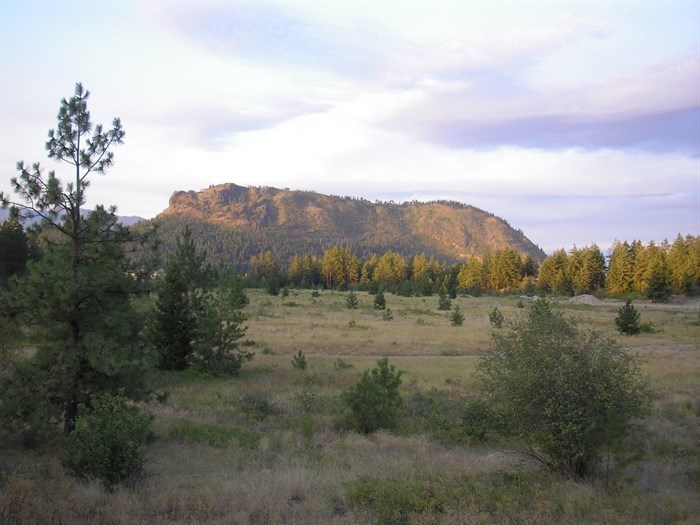
The north face of Mount Boucherie.
Image Credit: Wikipedia Commons
October 04, 2020 - 3:00 PM
Step back in time roughly 40 million years and you’ll see the Okanagan Valley filled with gushing volcanoes, including at Knox Mountain, Dilworth and Mount Boucherie.
The Okanagan Valley formed roughly 60 million years ago from rifting, not glaciation, contrary to popular belief, said Robert Young, geography professor at UBC Okanagan.
“If a glacier eroded it, we’d expect to find all that volume of material at the end of where the glacier terminated during the ice age and there’s practically nothing there,” he said.
The valley didn’t exist when dinosaurs roamed the earth, he said. During the Mesozoic era, 251 to 65 million years ago, volcanic islands collided with North America’s west coast. The land was force eastward, creating mountain ranges.
READ MORE: Mammoths claimed the Thompson Okanagan as their home more than 10,000 years ago
When the compression stopped roughly 55 million years ago, the land relaxed and giant faults were created, including the Okanagan Valley Fault, according to Okanagan Heritage Museums.
During that rifting incident, the earth’s crust became thinner, meaning that underlying magma rushed to the surface, forming numerous volcanoes, Young said. Volcanoes could be found between 57 to 38 million years ago.
Mount Boucherie, Knox Mountain and Dilworth were once volcanoes, Young said.
There is also evidence of volcanic activity in the Okanagan as early as 5 million years ago, with lava forming what is now Layer Cake Mountain. Masses of hard molten rock found near Westside Road Interchange shows evidence that Lambly Creek was once the scene of volcanic activity on the Westside roughly 800,000 thousand years ago, he said.
The Okanagan Valley’s active volcanic centre seems to have migrated north into the Wells Gray and Clearwater area, he speculates, as volcanic activity seemed to cease in the Okanagan around the time it began in the provincial park area during the last glaciation from roughly 25,000 to 10,000 years ago. Lava could be found under the ice in Wells Gray Provincial Park during that time, Young said.
READ MORE: Mammoth's tooth found in Williams Lake and preserved for decades by B.C. family
“Episodes of volcanism has been going off and on for several thousand years in Wells Gray,” he said. “It’d be hundreds of thousands, if not millions of years in the future (to see volcanic activity in the Okanagan Valley again),” he said, adding that Wells Gray could see volcanic activity again in the next few centuries, but that’s just a guess.
It’s hard to predict where the magma bodies are, but the most likely spots are near Lambly Creek and Layer Cake Mountain, Young said, as they have had the more recent volcanic activity.
The Okanagan Heritage Museum has a full display of how the Okanagan Valley was formed.
To contact a reporter for this story, email Carli Berry or call 250-864-7494 or email the editor. You can also submit photos, videos or news tips to the newsroom and be entered to win a monthly prize draw.
We welcome your comments and opinions on our stories but play nice. We won't censor or delete comments unless they contain off-topic statements or links, unnecessary vulgarity, false facts, spam or obviously fake profiles. If you have any concerns about what you see in comments, email the editor in the link above.
News from © iNFOnews, 2020